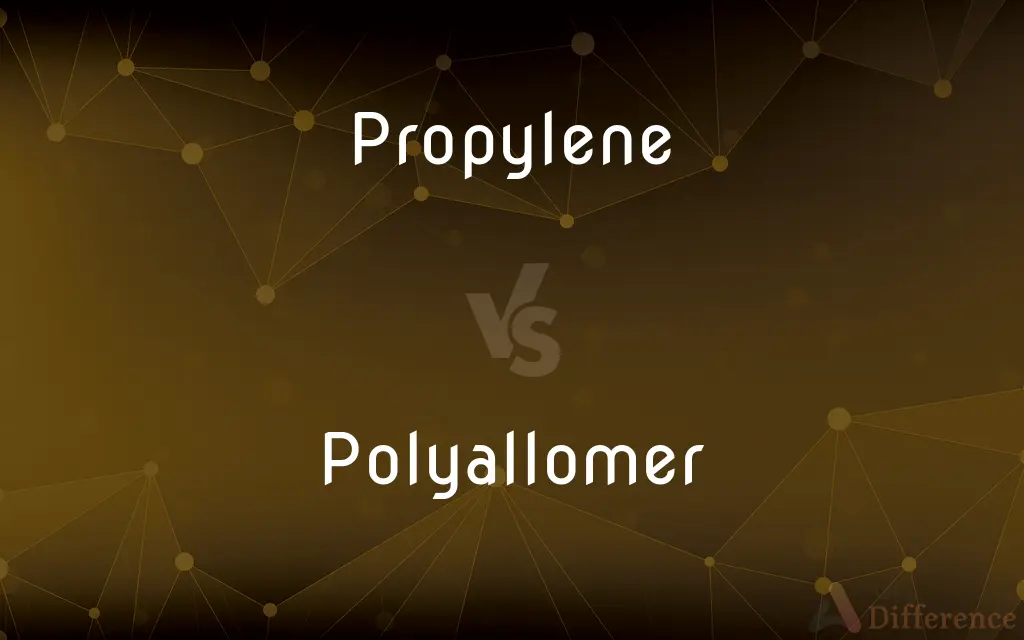Propylene vs. Polyallomer — What's the Difference?
Edited by Tayyaba Rehman — By Fiza Rafique — Updated on March 24, 2024
Propylene is a hydrocarbon gas used as a building block for various plastics, while polyallomer is a copolymer plastic with broad applications, from packaging to automotive parts.

Difference Between Propylene and Polyallomer
Table of Contents
ADVERTISEMENT
Key Differences
Propylene, also known as propene, is a volatile, colorless gas at room temperature, widely used in the chemical industry as a raw material for the production of polypropylene, a common plastic. Polyallomer, on the other hand, is a specific type of copolymer made by polymerizing propylene with one or more other monomers, designed to combine the properties of these materials to create a versatile and durable plastic.
While propylene itself is a gas and not directly used in final consumer products, its polymerized form, polypropylene, shares many characteristics with polyallomer. Polyallomer is crafted to have specific properties such as increased flexibility, toughness, and chemical resistance, depending on the application. This makes it useful in a variety of industries, from medical to automotive.
The production process of these materials marks a significant difference. Propylene is produced through the refining of petroleum or the processing of natural gas, making it a basic petrochemical. Polyallomer, however, is produced through a more complex polymerization process that involves not only propylene but also other monomers, which are chemically bonded to create the copolymer.
In terms of applications, polyallomer is often chosen for products where flexibility and impact resistance are crucial, such as in packaging solutions, automotive parts, and some medical devices. Propylene's primary role is as a feedstock for manufacturing polymers like polypropylene and polyallomer, highlighting its importance in the chemical industry rather than direct consumer applications.
Environmental considerations also differ between the two. Propylene, as a gas, has implications for energy use and emissions in its production processes. Polyallomer, being a solid plastic, raises questions about recyclability, longevity, and environmental impact of the products made from it. Both materials reflect the broader challenges and considerations in the use of plastics and petrochemicals.
ADVERTISEMENT
Comparison Chart
State at Room Temperature
Gas
Solid Plastic
Production
Refining of petroleum or natural gas processing
Polymerization of propylene with other monomers
Primary Use
Feedstock for plastics like polypropylene
Packaging, automotive parts, medical devices
Characteristics
Colorless, volatile gas
Flexible, tough, chemically resistant
Environmental Considerations
Energy use and emissions in production
Recyclability, product longevity, environmental impact
Compare with Definitions
Propylene
A compound consisting of hydrogen and carbon.
Propylene is a hydrocarbon gas widely used in the chemical industry.
Polyallomer
Parts used in the manufacture of vehicles.
Polyallomer is used in automotive parts due to its impact resistance.
Propylene
A substance from which polymers are synthesized.
Propylene is polymerized to create polypropylene.
Polyallomer
A material used for packaging goods.
Polyallomer's durability makes it suitable for various packaging applications.
Propylene
A raw material used in the production of chemical products.
Propylene serves as a chemical feedstock for making various plastics.
Polyallomer
Plastics that can be recycled to reduce waste.
Polyallomer can be designed to be recyclable, contributing to environmental sustainability.
Propylene
A chemical obtained from petroleum and natural gas.
As a petrochemical, propylene is fundamental to the plastic manufacturing industry.
Polyallomer
A plastic made from polymerizing two or more different monomers.
Polyallomer is a copolymer plastic known for its toughness and flexibility.
Propylene
Gases used in industrial processes.
Propylene is used as an industrial gas in the production of other chemicals.
Polyallomer
Materials suitable for use in healthcare devices.
Polyallomer's chemical resistance makes it ideal for certain medical devices.
Propylene
A flammable gaseous alkene, C3H6, derived from petroleum hydrocarbon cracking and used in organic synthesis. Also called propene.
Polyallomer
Any of a class of crystalline thermoplastics which are copolymers of two or more different alkenes, especially ethylene and propylene.
Propylene
(organic compound) The organic chemical compound propene. An alkene which is a colorless gaseous (at room temperature and pressure) hydrocarbon with the chemical formula C3H6.
Polyallomer
(chemistry) A copolymer of more than one olefin, especially of propylene and another olefin
Propylene
A colorless gaseous hydrocarbon (C3H6) of the ethylene series, having a garlic odor. It occurs in coal gas, and is produced artificially in various ways. Called also propene.
Propylene
A flammable gas obtained by cracking petroleum; used in organic synthesis
Common Curiosities
What makes polyallomer suitable for automotive parts?
Its combination of flexibility, toughness, and chemical resistance makes it ideal for various automotive applications.
How is propylene produced?
It is produced through the refining of petroleum or the processing of natural gas.
What is the significance of propylene in the chemical industry?
Its role as a fundamental feedstock for producing a wide range of plastics underscores its significance.
What is propylene used for?
Propylene is primarily used as a feedstock for manufacturing polymers like polypropylene.
Can polyallomer be recycled?
Yes, polyallomer can be designed to be recyclable, depending on its specific composition and use.
What are the key physical properties of propylene?
Propylene is a colorless, flammable gas with a slightly sweet odor.
How is polyallomer different from polypropylene?
Polyallomer is a copolymer made from propylene and other monomers, designed for specific properties like increased toughness, whereas polypropylene is a polymer made solely from propylene.
How does the production process of polyallomer impact its properties?
The polymerization process, including the types and ratios of monomers used, can be tailored to achieve desired properties like toughness and chemical resistance.
Is propylene a solid or a gas?
Propylene is a colorless, volatile gas at room temperature.
Are products made from polyallomer environmentally friendly?
The environmental friendliness of polyallomer products depends on their recyclability and the sustainability practices in their production and disposal.
What industries use polyallomer?
Industries like packaging, automotive, and medical devices use polyallomer for its versatile properties.
Is propylene environmentally hazardous?
While propylene itself has fewer direct environmental impacts, the processes to produce and convert it into plastics raise concerns about energy use and emissions.
Why is propylene important for plastic production?
Its versatility and ability to be polymerized into a variety of plastics make propylene a critical component in the plastic production industry.
Can polyallomer be used in food packaging?
Yes, when manufactured according to food safety standards, polyallomer can be used in food packaging.
How does polyallomer contribute to sustainability?
By being recyclable and adaptable for various uses, polyallomer can contribute to sustainability efforts, though its overall impact depends on the lifecycle management of the products made from it.
Share Your Discovery

Previous Comparison
Lend vs. Lent
Next Comparison
Scrumpy vs. CiderAuthor Spotlight
Written by
Fiza RafiqueFiza Rafique is a skilled content writer at AskDifference.com, where she meticulously refines and enhances written pieces. Drawing from her vast editorial expertise, Fiza ensures clarity, accuracy, and precision in every article. Passionate about language, she continually seeks to elevate the quality of content for readers worldwide.
Edited by
Tayyaba RehmanTayyaba Rehman is a distinguished writer, currently serving as a primary contributor to askdifference.com. As a researcher in semantics and etymology, Tayyaba's passion for the complexity of languages and their distinctions has found a perfect home on the platform. Tayyaba delves into the intricacies of language, distinguishing between commonly confused words and phrases, thereby providing clarity for readers worldwide.
















































